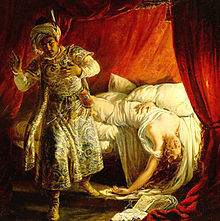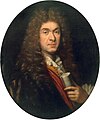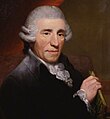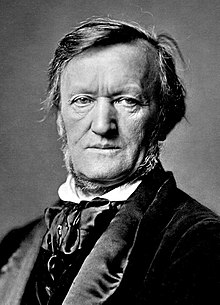Portal:Classical music
Portal maintenance status: (June 2018)
|
The Classical Music Portal


Classical music generally refers to the art music of the Western world, considered to be distinct from Western folk music or popular music traditions. It is sometimes distinguished as Western classical music, as the term "classical music" can also be applied to non-Western art musics. Classical music is often characterized by formality and complexity in its musical form and harmonic organization, particularly with the use of polyphony. Since at least the ninth century it has been primarily a written tradition, spawning a sophisticated notational system, as well as accompanying literature in analytical, critical, historiographical, musicological and philosophical practices. A foundational component of Western culture, classical music is frequently seen from the perspective of individual or groups of composers, whose compositions, personalities and beliefs have fundamentally shaped its history. (Full article...)
Selected articles - load new batch
-
Image 1Cover of the symphony, with the dedication to Prince J. F. M. Lobkowitz and Count Rasumovsky
The Symphony No. 5 in C minor, Op. 67, also known as the Fate Symphony (German: Schicksalssinfonie), is a symphony composed by Ludwig van Beethoven between 1804 and 1808. It is one of the best-known compositions in classical music and one of the most frequently played symphonies, and it is widely considered one of the cornerstones of western music. First performed in Vienna's Theater an der Wien in 1808, the work achieved its prodigious reputation soon afterward. E. T. A. Hoffmann described the symphony as "one of the most important works of the time". As is typical of symphonies during the Classical period, Beethoven's Fifth Symphony has four movements.
It begins with a distinctive four-note "short-short-short-long" motif, often characterized as "fate knocking at the door", the Schicksals-Motiv (fate motif): (Full article...) -
Image 2
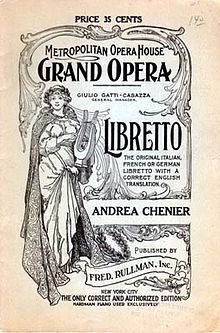
Cover of a 1921 libretto for Giordano's Andrea Chénier
A libretto (From the Italian word libretto, lit. 'booklet') is the text used in, or intended for, an extended musical work such as an opera, operetta, masque, oratorio, cantata or musical. The term libretto is also sometimes used to refer to the text of major liturgical works, such as the Mass, requiem and sacred cantata, or the story line of a ballet.
The Italian word libretto (pronounced [liˈbretto], plural libretti [liˈbretti]) is the diminutive of the word libro ("book"). Sometimes other-language equivalents are used for libretti in that language, livret for French works, Textbuch for German and libreto for Spanish. A libretto is distinct from a synopsis or scenario of the plot, in that the libretto contains all the words and stage directions, while a synopsis summarizes the plot. Some ballet historians also use the word libretto to refer to the 15- to 40-page books which were on sale to 19th century ballet audiences in Paris and contained a very detailed description of the ballet's story, scene by scene. (Full article...) -
Image 3Otello and Desdemona
by Alexandre-Marie Colin, 1829
Otello (Italian pronunciation: [oˈtɛllo]) is an opera in four acts by Giuseppe Verdi to an Italian libretto by Arrigo Boito, based on Shakespeare's play Othello. It was Verdi's penultimate opera, first performed at the Teatro alla Scala, Milan, on 5 February 1887.
The composer was reluctant to write anything new after the success of Aida in 1871, and he retreated into retirement. It took his Milan publisher Giulio Ricordi the next ten years, first to encourage the revision of Verdi's 1857 Simon Boccanegra by introducing Boito as librettist and then to begin the arduous process of persuading and cajoling Verdi to see Boito's completed libretto for Otello in July/August 1881. However, the process of writing the first drafts of the libretto and the years of their revision, with Verdi all along not promising anything, dragged on. It wasn't until 1884, five years after the first drafts of the libretto, that composition began, with most of the work finishing in late 1885. When it finally premiered in Milan on 5 February 1887, it proved to be a resounding success, and further stagings of Otello soon followed at leading theatres throughout Europe and America. (Full article...) -
Image 4
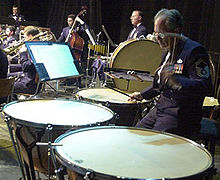
Timpani (/ˈtɪmpəni/; Italian pronunciation: [ˈtimpani]) or kettledrums (also informally called timps) are musical instruments in the percussion family. A type of drum categorised as a hemispherical drum, they consist of a membrane called a head stretched over a large bowl traditionally made of copper. Thus timpani are an example of kettledrums, also known as vessel drums and semispherical drums, whose body is similar to a section of a sphere whose cut conforms the head. Most modern timpani are pedal timpani and can be tuned quickly and accurately to specific pitches by skilled players through the use of a movable foot-pedal. They are played by striking the head with a specialized beater called a timpani stick or timpani mallet. Timpani evolved from military drums to become a staple of the classical orchestra by the last third of the 18th century. Today, they are used in many types of ensembles, including concert bands, marching bands, orchestras, and even in some rock bands.
Timpani is an Italian plural, the singular of which is timpano. However, in English the term timpano is only widely in use by practitioners: several are more typically referred to collectively as kettledrums, timpani, temple drums, or timps. They are also often incorrectly termed timpanis. A musician who plays timpani is a timpanist. (Full article...) -
Image 5
Peer Gynt, Op. 23, is the incidental music to Henrik Ibsen's 1867 play Peer Gynt, written by the Norwegian composer Edvard Grieg in 1875. It premiered along with the play on 24 February 1876 in Christiania (now Oslo).
Grieg later created two suites from his Peer Gynt music. Some of the music from these suites has received coverage in popular culture. (Full article...) -
Image 6A page (leaf 12 recto) from Beethoven's manuscript
The Symphony No. 9 in D minor, Op. 125, is a choral symphony, the final complete symphony by Ludwig van Beethoven, composed between 1822 and 1824. It was first performed in Vienna on 7 May 1824. The symphony is regarded by many critics and musicologists as a masterpiece of Western classical music and one of the supreme achievements in the history of music. One of the best-known works in common practice music, it stands as one of the most frequently performed symphonies in the world.
The Ninth was the first example of a major composer scoring vocal parts in a symphony. The final (4th) movement of the symphony, commonly known as the Ode to Joy, features four vocal soloists and a chorus in the parallel key of D major. The text was adapted from the "An die Freude (Ode to Joy)", a poem written by Friedrich Schiller in 1785 and revised in 1803, with additional text written by Beethoven. In the 20th century, an instrumental arrangement of the chorus was adopted by the Council of Europe, and later the European Union, as the Anthem of Europe. (Full article...) -
Image 7

Giovanni Pierluigi da Palestrina (between 3 February 1525 and 2 February 1526 – 2 February 1594) was an Italian composer of late Renaissance music. The central representative of the Roman School, with Orlande de Lassus and Tomás Luis de Victoria, Palestrina is considered the leading composer of late 16th-century Europe.
Primarily known for his masses and motets, which number over 105 and 250 respectively, Palestrina had a long-lasting influence on the development of church and secular music in Europe, especially on the development of counterpoint. According to Grove Music Online, Palestrina's "success in reconciling the functional and aesthetic aims of Catholic church music in the post-Tridentine period earned him an enduring reputation as the ideal Catholic composer, as well as giving his style (or, more precisely, later generations' selective view of it) an iconic stature as a model of perfect achievement." (Full article...) -
Image 8Portrait of Francisco D'Andrade in the title role by Max Slevogt, 1912
Don Giovanni (Italian pronunciation: [ˌdɔn dʒoˈvanni]; K. 527; Vienna (1788) title: Il dissoluto punito, ossia il Don Giovanni, literally The Rake Punished, or Don Giovanni) is an opera in two acts with music by Wolfgang Amadeus Mozart to an Italian libretto by Lorenzo Da Ponte. Its subject is a centuries-old Spanish legend about a libertine as told by playwright Tirso de Molina in his 1630 play El burlador de Sevilla y convidado de piedra. It is a dramma giocoso blending comedy, melodrama and supernatural elements (although the composer entered it into his catalogue simply as opera buffa). It was premiered by the Prague Italian opera at the National Theatre (of Bohemia), now called the Estates Theatre, on 29 October 1787. Don Giovanni is regarded as one of the greatest operas of all time, and has proved a fruitful subject for commentary in its own right; critic Fiona Maddocks has described it as one of Mozart's "trio of masterpieces with librettos by Da Ponte". (Full article...) -
Image 9

Antonio Stradivari (/ˌstrædɪˈvɑːri/, also US: /-ˈvɛəri/, Italian: [anˈtɔːnjo stradiˈvaːri]; c. 1644 – 18 December 1737) was an Italian luthier and a craftsman of string instruments such as violins, cellos, guitars, violas and harps. The Latinized form of his surname, Stradivarius, as well as the colloquial Strad are terms often used to refer to his instruments. It is estimated that Stradivari produced 1,116 instruments, of which 960 were violins. Around 650 instruments survive, including 450 to 512 violins. His instruments are considered some of the finest ever made, and are extremely valuable collector's items. (Full article...) -
Image 10
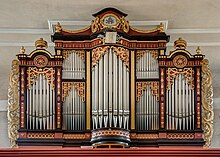
The pipe organ is a musical instrument that produces sound by driving pressurised air (called wind) through the organ pipes selected from a keyboard. Because each pipe produces a single pitch, the pipes are provided in sets called ranks, each of which has a common timbre, volume, and construction throughout the keyboard compass. Most organs have many ranks of pipes of differing pitch, timbre, and volume that the player can employ singly or in combination through the use of controls called stops.
A pipe organ has one or more keyboards (called manuals) played by the hands, and a pedal clavier played by the feet; each keyboard controls its own division (group of stops). The keyboard(s), pedalboard, and stops are housed in the organ's console. The organ's continuous supply of wind allows it to sustain notes for as long as the corresponding keys are pressed, unlike the piano and harpsichord whose sound begins to dissipate immediately after a key is depressed. The smallest portable pipe organs may have only one or two dozen pipes and one manual; the largest organs may have over 33,000 pipes and as many as seven manuals. A list of some of the most notable and largest pipe organs in the world can be viewed at List of pipe organs. A ranking of the largest organs in the world—based on the criterion constructed by Michał Szostak, i.e. 'the number of ranks and additional equipment managed from a single console'—can be found in the quarterly magazine The Organ and in the online journal Vox Humana. (Full article...) -
Image 11

Modest Petrovich Mussorgsky (Russian: Модест Петрович Мусоргский, romanized: Modest Petrovich Musorgsky, IPA: [mɐˈdɛst pʲɪˈtrovʲɪtɕ ˈmusərkskʲɪj] ⓘ; 21 March [O.S. 9 March] 1839 – 28 March [O.S. 16 March] 1881) was a Russian composer, one of the group known as "The Five." He was an innovator of Russian music in the Romantic period. He strove to achieve a uniquely Russian musical identity, often in deliberate defiance of the established conventions of Western music.
Many of his works were inspired by Russian history, Russian folklore, and other national themes. Such works include the opera Boris Godunov, the orchestral tone poem Night on Bald Mountain and the piano suite Pictures at an Exhibition. (Full article...) -
Image 12First edition title page, Ricordi, 1874
The Messa da Requiem is a musical setting of the Catholic funeral mass (Requiem) for four soloists, double choir and orchestra by Giuseppe Verdi. It was composed in memory of Alessandro Manzoni, whom Verdi admired, and therefore also referred to as the Manzoni Requiem. The first performance, at the San Marco church in Milan on 22 May 1874, conducted by the composer, marked the first anniversary of Manzoni's death. It was followed three days later by the same performers at La Scala. Verdi conducted his work at major venues in Europe.
Verdi composed the last part of the text, Libera me, first, as his contribution to the Messa per Rossini that he had begun after Gioachino Rossini had died, already contained the music that later begins the Dies irae sequence. (Full article...)
General images - load new batch
-
Image 1Hummel in 1814 (from Classical period (music))
-
Image 2A modern string quartet. In the 2000s, string quartets from the Classical era are the core of the chamber music literature. From left to right: violin 1, violin 2, cello, viola (from Classical period (music))
-
Image 5The Mozart family c. 1780. The portrait on the wall is of Mozart's mother. (from Classical period (music))
-
Image 61875 oil painting of Franz Schubert by Wilhelm August Rieder, after his own 1825 watercolor portrait (from Classical period (music))
-
Image 8Portion of Du Fay's setting of Ave maris stella, in fauxbourdon. The top line is a paraphrase of the chant; the middle line, designated "fauxbourdon", (not written) follows the top line but exactly a perfect fourth below. The bottom line is often, but not always, a sixth below the top line; it is embellished, and reaches cadences on the octave.Play (from Renaissance music)
-
Image 9Gluck, detail of a portrait by Joseph Duplessis, dated 1775 (Kunsthistorisches Museum, Vienna) (from Classical period (music))
-
Image 12Fortepiano by Paul McNulty after Walter & Sohn, c. 1805 (from Classical period (music))
-
Image 13Selection of Renaissance instruments (from Renaissance music)
-
Image 14Painting by Evaristo Baschenis of Baroque instruments, including a cittern, viola da gamba, violin, and two lutes (from Baroque music)
-
Image 16Individual sheet music for a seventeenth-century harp. (from Baroque music)
-
Image 17A large instrumental ensemble's performance in the lavish Teatro Argentina, as depicted by Panini (1747) (from Baroque music)
-
Image 21Richard Wagner in Paris, 1861
-
Image 22Marc-Antoine Charpentier (from Baroque music)
-
Image 23Wanderer above the Sea of Fog, by Caspar David Friedrich, is an example of Romantic painting. (from Romantic music)
-
Image 24Gustav Mahler, photographed in 1907 by Moritz Nähr at the end of his period as director of the Vienna Hofoper (from Romantic music)
-
Image 25Balakirev (top), Cui (upper left), Mussorgsky (upper right), Rimsky-Korsakov (lower left), and Borodin (lower right). (from Romantic music)
-
Image 28Gerard van Honthorst, The Concert (1623), National Gallery of Art, Washington D.C. (from Renaissance music)
-
Image 29Double-manual harpsichord by Vital Julian Frey, after Jean-Claude Goujon (1749) (from Baroque music)
-
Image 30Musicians from 'Procession in honour of Our Lady of Sablon in Brussels.' Early 17th-century Flemish alta cappella. From left to right: bass dulcian, alto shawm, treble cornett, soprano shawm, alto shawm, tenor sackbut. (from Renaissance music)
-
Image 33A young Wolfgang Amadeus Mozart, a representative composer of the Classical period, seated at a keyboard. (from Classical period (music))
-
Image 34Wolfgang Amadeus Mozart, posthumous painting by Barbara Krafft in 1819 (from Classical period (music))
-
Image 35Bernhard Crusell, a Swedish-Finnish composer and clarinetist, in 1826 (from Classical period (music))
-
Image 36The opening bars of the Commendatore's aria in Mozart's opera Don Giovanni. The orchestra starts with a dissonant diminished seventh chord (G# dim7 with a B in the bass) moving to a dominant seventh chord (A7 with a C# in the bass) before resolving to the tonic chord (D minor) at the singer's entrance. (from Classical period (music))
-
Image 37Josef Danhauser's 1840 painting of Franz Liszt at the piano surrounded by (from left to right) Alexandre Dumas, Hector Berlioz, George Sand, Niccolò Paganini, Gioachino Rossini and Marie d'Agoult, with a bust of Ludwig van Beethoven on the piano (from Romantic music)
Quotes - show another
| “ | Music, even in situations of the greatest horror, should never be painful to the ear but should flatter and charm it, and thereby always remain music. | ” |
| — Wolfgang Amadeus Mozart | ||
Related portals
WikiProjects
 Selected composers - load new batch
Selected composers - load new batch 
-
Image 1
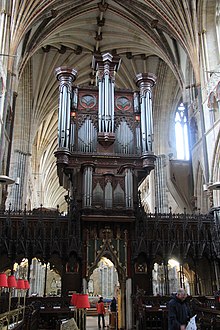
The organ at Exeter Cathedral, which Gibbons may have played
Edward Gibbons (bapt. 21 March 1568 – in or before July 1650) was an English choirmaster and composer of the late Renaissance and early Baroque periods. Born in Cambridge, Gibbons's youth is completely unknown, but he later received degrees from the Universities of Cambridge and Oxford. From 1591/92 to 1598 he worked at King's College, Cambridge, as a lay clerk and choirmaster. During his tenure he married Jane, with whom he had six children. Gibbons's whereabouts the next few years remain uncertain; he may have lived in Acton, Bristol or Exeter, but by 1607 he was the choirmaster of the Exeter Cathedral, where the choristers included Matthew Locke. By 1609 Gibbons received a special dispensation to become a priest vicar, becoming the head of the college of priest-vicars and succentor. Jane died in 1628, and Edward married Mary Bluet; the family was evicted from their home during the English Civil War, but moved to their estate in Dunsford.
A few compositions of Gibbons survive: an organ prelude, two verse anthems, two works for viol consorts, and some sacred music. Of these, commentators have mainly praised the verse anthems, How hath ye City sate solitary and What Strikes the Clocke? Musicologist John Harley called the former particularly moving, and it was likely written for the 1603 London plague outburst to which Gibbons's brother Ellis may have succumbed to. Edward is the elder brother of the better-known Orlando; after the early deaths of Orlando and his wife, Edward cared for their son, Christopher, who also became a noted composer. (Full article...) -
Image 2
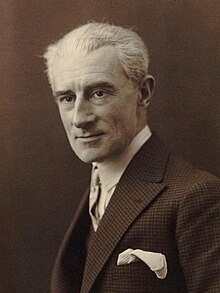
Ravel in 1925
Joseph Maurice Ravel (7 March 1875 – 28 December 1937) was a French composer, pianist and conductor. He is often associated with Impressionism along with his elder contemporary Claude Debussy, although both composers rejected the term. In the 1920s and 1930s Ravel was internationally regarded as France's greatest living composer.
Born to a music-loving family, Ravel attended France's premier music college, the Paris Conservatoire; he was not well regarded by its conservative establishment, whose biased treatment of him caused a scandal. After leaving the conservatoire, Ravel found his own way as a composer, developing a style of great clarity and incorporating elements of modernism, baroque, neoclassicism and, in his later works, jazz. He liked to experiment with musical form, as in his best-known work, Boléro (1928), in which repetition takes the place of development. Renowned for his abilities in orchestration, Ravel made some orchestral arrangements of other composers' piano music, of which his 1922 version of Mussorgsky's Pictures at an Exhibition is the best known. (Full article...) -
Image 3Philibert Rabezoza (1923 – 29 September 2001), better known by the name Rakoto Frah, was a flautist and composer of traditional music of the central highlands of Madagascar. Born in 1923 near the capital city of Antananarivo to a poor rural family, Rakoto Frah surmounted the challenges posed by his underprivileged origins to become the most acclaimed 20th century performer of the sodina flute, one of the oldest traditional instruments on the island. Through frequent international concerts and music festival performances, he promoted the music of the highlands of Madagascar and became one of the most famous Malagasy artists, both within Madagascar and on the world music scene.
After gaining regional recognition for his sodina skills as a youth, Rakoto Frah rose to national fame in 1958 when he was selected by Malagasy President Philibert Tsiranana to perform on the sodina for the visiting French president Charles de Gaulle. This event launched his career as a professional musician. He first played at traditional ceremonies around the country, then expanded his performances from 1967 to include participation in international music competitions and festivals. His popularity declined in the 1970s but underwent a revival that began in the mid-1980s and continued until his death in 2001. During this period Rakoto Frah recorded ten albums, toured extensively in Madagascar and overseas, was featured in two French documentaries, and collaborated with a variety of international and Malagasy artists. Over the course of his career he recorded over 800 original compositions. Rakoto Frah and his sodina were depicted on the 200 ariary Malagasy banknote in honor of his key role in revitalizing and internationally popularizing the sodina. Despite the artist's worldwide acclaim, he lived simply and died having earned little from his lifetime of musicianship. His death was widely mourned and marked by a state funeral, and in 2011 a famadihana (the Malagasy highland "turning of the bones" funerary tradition) was organized to celebrate the artist's life. (Full article...) -
Image 4

Messager in 1921 
André Charles Prosper Messager (French: [mɛsaʒe]; 30 December 1853 – 24 February 1929) was a French composer, organist, pianist and conductor. His compositions include eight ballets and thirty opéras comiques, opérettes and other stage works, among which his ballet Les Deux Pigeons (1886) and opéra comique Véronique (1898) have had lasting success; Les p'tites Michu (1897) and Monsieur Beaucaire (1919) were also popular internationally.
Messager took up the piano as a small child and later studied composition with, among others, Camille Saint-Saëns and Gabriel Fauré. He became a major figure in the musical life of Paris and later London, both as a conductor and a composer. Many of his Parisian works were also produced in the West End and some on Broadway; the most successful had long runs and numerous international revivals. He wrote two operatic works in English, and his later output included musical comedies for Sacha Guitry and Yvonne Printemps. (Full article...) -
Image 5Erik William Chisholm (4 January 1904 – 8 June 1965) was a Scottish composer, pianist, organist and conductor sometimes known as "Scotland's forgotten composer". According to his biographer, Chisholm "was the first composer to absorb Celtic idioms into his music in form as well as content, his achievement paralleling that of Bartók in its depth of understanding and its daring", which led some to give him the nickname "MacBartók". As composer, performer and impresario, he played an important role in the musical life of Glasgow between the two World Wars and was a founder of the Celtic Ballet and, together with Margaret Morris, created the first full-length Scottish ballet, The Forsaken Mermaid. After World War II he was Professor and Head of the South African College of Music at the University of Cape Town for 19 years until his death. Chisholm founded the South African College of Music opera company in Cape Town and was a vital force in bringing new operas to Scotland, England and South Africa. By the time of his death in 1965, he had composed over a hundred works. (Full article...)
-
Image 6
Kaikhosru Shapurji Sorabji (born Leon Dudley Sorabji; 14 August 1892 – 15 October 1988) was an English composer, music critic, pianist and writer whose music, written over a period of seventy years, ranges from sets of miniatures to works lasting several hours. One of the most prolific 20th-century composers, he is best known for his piano pieces, notably nocturnes such as Gulistān and Villa Tasca, and large-scale, technically intricate compositions, which include seven symphonies for piano solo, four toccatas, Sequentia cyclica and 100 Transcendental Studies. He felt alienated from English society by reason of his homosexuality and mixed ancestry, and had a lifelong tendency to seclusion.
Sorabji was educated privately. His mother was English and his father a Parsi businessman and industrialist from India, who set up a trust fund that freed his family from the need to work. Although Sorabji was a reluctant performer and not a virtuoso, he played some of his music publicly between 1920 and 1936. In the late 1930s, his attitude shifted and he imposed restrictions on performance of his works, which he lifted in 1976. His compositions received little exposure in those years and he remained in public view mainly through his writings, which include the books Around Music and Mi contra fa: The Immoralisings of a Machiavellian Musician. During this time, he also left London and eventually settled in the village of Corfe Castle, Dorset. Information on Sorabji's life, especially his later years, is scarce, with most of it coming from the letters he exchanged with his friends. (Full article...) -
Image 7

Britten in 1968, by Hans Wild
Edward Benjamin Britten, Baron Britten OM CH (22 November 1913 – 4 December 1976) was an English composer, conductor, and pianist. He was a central figure of 20th-century British music, with a range of works including opera, other vocal music, orchestral and chamber pieces. His best-known works include the opera Peter Grimes (1945), the War Requiem (1962) and the orchestral showpiece The Young Person's Guide to the Orchestra (1945).
Britten was born in Lowestoft, Suffolk, the son of a dentist. He showed talent from an early age. He studied at the Royal College of Music in London and privately with the composer Frank Bridge. Britten first came to public attention with the a cappella choral work A Boy Was Born in 1934. With the premiere of Peter Grimes in 1945, he leapt to international fame. Over the next 28 years, he wrote 14 more operas, establishing himself as one of the leading 20th-century composers in the genre. In addition to large-scale operas for Sadler's Wells and Covent Garden, he wrote chamber operas for small forces, suitable for performance in venues of modest size. Among the best known of these is The Turn of the Screw (1954). Recurring themes in his operas include the struggle of an outsider against a hostile society and the corruption of innocence. (Full article...) -
Image 8Ellis Gibbons (bapt. 30 November 1573 – 14? May 1603) was an English composer of the late Renaissance who was associated with the English Madrigal School. Born in Cambridge to a musical family, Gibbons was the second surviving son of William Gibbons, a town wait. By 1598 he was known to be living in Cambridge's High ward, and later the Market ward. He owned property in Cambridge and London and probably spent much time there, presumably as a musician of some kind (although this has never been verified). At the age of 28 he became one of only two composers to contribute two pieces to The Triumphs of Oriana, a collection of 25 madrigals published in 1601. These madrigals were Long live faire Oriana and Round about her Charret; modern commentators generally favor the latter. No other compositions by Gibbons survive, and some scholars have doubted his authorship of these works, ascribing them to his brothers. Two months after his mother's death, his career was cut short by his early death in May 1603, leaving behind his brothers Edward, Ferdinando and Orlando, who would become the most famous musician of the family. Orlando's son, Christopher, was also a noted composer. (Full article...)
-
Image 9
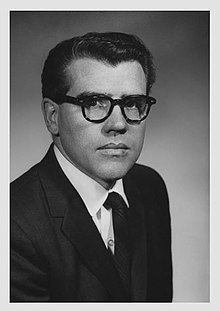
Merrill Bradshaw in 1963
Merrill Bradshaw (June 18, 1929 – July 12, 2000) was an American composer and professor at Brigham Young University (BYU), where he was composer-in-residence from 1967 to 1994.
Bradshaw grew up in Lyman, Wyoming; Salt Lake City, Utah; and Portland, Oregon. He was a member of the Church of Jesus Christ of Latter-day Saints (LDS Church). He studied music theory at BYU with John R. Halliday and others, after which he continued his studies in composition at the University of Illinois. He became a faculty member at BYU in 1957. He was chairman of composition and theory from 1973 to 1983, and the executive director of the Barlow Endowment for Music Composition from 1983 to 1999. From 1973 to 1978 he chaired an LDS Church committee to revise the hymnbook, although the committee was suspended before they published their intended hymnal. A different committee authored the 1985 hymnal. (Full article...) -
Image 10

Busoni in 1913
Ferruccio Busoni (1 April 1866 – 27 July 1924) was an Italian composer, pianist, conductor, editor, writer, and teacher. His international career and reputation led him to work closely with many of the leading musicians, artists and literary figures of his time, and he was a sought-after keyboard instructor and a teacher of composition.
From an early age, Busoni was an outstanding, if sometimes controversial, pianist. He studied at the Vienna Conservatory and then with Wilhelm Mayer and Carl Reinecke. After brief periods teaching in Helsinki, Boston, and Moscow, he devoted himself to composing, teaching, and touring as a virtuoso pianist in Europe and the United States. His writings on music were influential, and covered not only aesthetics but considerations of microtones and other innovative topics. He was based in Berlin from 1894 but spent much of World War I in Switzerland. (Full article...) -
Image 11
William Sterndale Bennett – engraving after a portrait by John Everett Millais, 1873
Sir William Sterndale Bennett (13 April 1816 – 1 February 1875) was an English composer, pianist, conductor and music educator. At the age of ten Bennett was admitted to the London Royal Academy of Music (RAM), where he remained for ten years. By the age of twenty, he had begun to make a reputation as a concert pianist, and his compositions received high praise. Among those impressed by Bennett was the German composer Felix Mendelssohn, who invited him to Leipzig. There Bennett became friendly with Robert Schumann, who shared Mendelssohn's admiration for his compositions. Bennett spent three winters composing and performing in Leipzig.
In 1837 Bennett began to teach at the RAM, with which he was associated for most of the rest of his life. For twenty years he taught there, later also teaching at Queen's College, London. Among his pupils during this period were Arthur Sullivan, Hubert Parry, and Tobias Matthay. Throughout the 1840s and 1850s he composed little, although he performed as a pianist and directed the Philharmonic Society for ten years. He also actively promoted concerts of chamber music. From 1848 onward, his career was punctuated by antagonism between himself and the conductor Michael Costa. (Full article...) -
Image 12

Nikolai Andreyevich Rimsky-Korsakov (18 March 1844 – 21 June 1908) was a Russian composer, a member of the group of composers known as The Five. He was a master of orchestration. His best-known orchestral compositions—Capriccio Espagnol, the Russian Easter Festival Overture, and the symphonic suite Scheherazade—are staples of the classical music repertoire, along with suites and excerpts from some of his fifteen operas. Scheherazade is an example of his frequent use of fairy-tale and folk subjects.
Rimsky-Korsakov believed in developing a nationalistic style of classical music, as did his fellow composer Mily Balakirev and the critic Vladimir Stasov. This style employed Russian folk song and lore along with exotic harmonic, melodic and rhythmic elements in a practice known as musical orientalism, and eschewed traditional Western compositional methods. Rimsky-Korsakov appreciated Western musical techniques after he became a professor of musical composition, harmony, and orchestration at the Saint Petersburg Conservatory in 1871. He undertook a rigorous three-year program of self-education and became a master of Western methods, incorporating them alongside the influences of Mikhail Glinka and fellow members of The Five. Rimsky-Korsakov's techniques of composition and orchestration were further enriched by his exposure to the works of Richard Wagner. (Full article...) -
Image 13
Wilhelm Richard Wagner (/ˈvɑːɡnər/ VAHG-nər; German: [ˈʁɪçaʁt ˈvaːɡnɐ] ⓘ; 22 May 1813 – 13 February 1883) was a German composer, theatre director, essayist, and conductor who is chiefly known for his operas (or, as some of his mature works were later known, "music dramas"). Unlike most opera composers, Wagner wrote both the libretto and the music for each of his stage works. Initially establishing his reputation as a composer of works in the romantic vein of Carl Maria von Weber and Giacomo Meyerbeer, Wagner revolutionised opera through his concept of the Gesamtkunstwerk ("total work of art"), by which he sought to synthesise the poetic, visual, musical and dramatic arts, with music subsidiary to drama. The drama was to be presented as a continuously sung narrative, without conventional operatic structures like arias and recitatives. He described this vision in a series of essays published between 1849 and 1852. Wagner realised these ideas most fully in the first half of the 16-hour, four-opera cycle Der Ring des Nibelungen (The Ring of the Nibelung, also known simply as The Ring).
Wagner's compositions, particularly those of his later period, are notable for their complex textures, rich harmonies and orchestration, and the elaborate use of leitmotifs—musical phrases associated with individual characters, places, ideas, or plot elements. His advances in musical language, such as extreme chromaticism and quickly shifting tonal centres, greatly influenced the development of classical music; his Tristan und Isolde is regarded as an important precursor towards modern music. As he matured, he softened his ideological stance against traditional operatic forms (ie. arias, ensembles and choruses), reintroducing them into his last few stage works, including Die Meistersinger von Nürnberg (The Mastersingers of Nuremberg) and Parsifal. (Full article...) -
Image 14

Poulenc in the early 1920s
Francis Jean Marcel Poulenc (French: [fʁɑ̃sis ʒɑ̃ maʁsɛl pulɛ̃k]; 7 January 1899 – 30 January 1963) was a French composer and pianist. His compositions include songs, solo piano works, chamber music, choral pieces, operas, ballets, and orchestral concert music. Among the best-known are the piano suite Trois mouvements perpétuels (1919), the ballet Les biches (1923), the Concert champêtre (1928) for harpsichord and orchestra, the Organ Concerto (1938), the opera Dialogues des Carmélites (1957), and the Gloria (1959) for soprano, choir, and orchestra.
As the only son of a prosperous manufacturer, Poulenc was expected to follow his father into the family firm, and he was not allowed to enrol at a music college. He studied with the pianist Ricardo Viñes, who became his mentor after the composer's parents died. Poulenc also made the acquaintance of Erik Satie, under whose tutelage he became one of a group of young composers known collectively as Les Six. In his early works Poulenc became known for his high spirits and irreverence. During the 1930s a much more serious side to his nature emerged, particularly in the religious music he composed from 1936 onwards, which he alternated with his more light-hearted works. (Full article...) -
Image 15Anthony Edward Payne (2 August 1936 – 30 April 2021) was an English composer, music critic and musicologist. He is best known for his acclaimed completion of Edward Elgar's third symphony, which gained wide acceptance into Elgar's oeuvre. Payne is particularly noted for his chamber music, much of which was written for his wife, the soprano Jane Manning, and the couple's new music ensemble Jane's Minstrels. Initially an unrelenting proponent of modernist music, by the 1980s his compositions had embraced aspects of the late English romanticism, described by his colleague Susan Bradshaw as "modernized nostalgia".
Born in London, Payne first seriously studied music at Durham University. His professional career began around 1969 with his first major work, the staunchly modernist Phoenix Mass for choir and brass band. He continued to write choral and vocal works, almost exclusively to British poets. From his 1981 chamber work A Day in the Life of a Mayfly on, he synthesised modernism with the English romanticism of Elgar, Delius and Vaughan Williams. Two orchestral commissions for The Proms, The Spirit's Harvest (1985) and Time's Arrow (1990) were well received. After his successful completion of Elgar's unfinished third symphony, Payne became unsure of his musical identity. He found difficulty in subsequent composition until a series of orchestral works for the Proms, Visions and Journeys (2002), The Period of Cosmographie (2010) and Of Land, Sea and Sky (2016). (Full article...)
Did you know (auto-generated) - load new batch

- ... that in 1994, Anthony Pople created two computer programs to analyse classical music?
- ... that gas lighting inspired Stephen Gunzenhauser to start a classical music festival?
- ... that WFMT classical music radio host Don Tait owned such a large collection of recordings that he had to buy a house and have its floor reinforced to accommodate the weight?
- ... that opera singer Charles Holland spent much of his career in Europe as opportunities in classical music for African Americans were limited?
- ... that the Stadthalle Hannover, the largest classical music concert hall in Germany by capacity, was modelled after the Pantheon in Rome and completed by 1914?
- ... that, according to its owner, KLEF in Anchorage, Alaska, was one of just three remaining commercially operated classical-music radio stations in the United States, as of 2013?
Selected image
-
Image 1Photo: Guillaume PiolleThe anatomy of a Périnet piston valve, this one taken from a B♭ trumpet. When depressed, the valve diverts the air stream through additional tubing, thus lengthening the instrument and lowering the harmonic series on which the instrument is vibrating (i.e., it lowers the pitch). Trumpets generally use three valves, with some variations, such as a piccolo trumpet, having four. When used singly or in combination, the valves make the instrument fully chromatic, or capable of playing all twelve pitches of classical music. Trumpets may also use rotary valves instead.
-
Image 2Photo: W. J. Mayer; Restoration: Lise BroerA bust of the German composer and pianist Ludwig van Beethoven (1770–1827), made from his death mask. He was a crucial figure in the transitional period between the Classical and Romantic eras in Western classical music, and remains one of the most acclaimed and influential composers of all time. Born in Bonn, of the Electorate of Cologne and a part of the Holy Roman Empire of the German Nation in present-day Germany, he moved to Vienna in his early twenties and settled there, studying with Joseph Haydn and quickly gaining a reputation as a virtuoso pianist. His hearing began to deteriorate in the late 1790s, yet he continued to compose, conduct, and perform, even after becoming completely deaf.
-
Image 3Photograph: David IliffThe Royal Albert Hall is a concert hall, seating a maximum of 5,272, on the northern edge of South Kensington, London. Constructed beginning in 1867, the hall was inaugurated on 29 March 1871. Since 1941 it has held The Proms, an eight-week summer season of daily orchestral classical music concerts and other events.
-
Image 4

A picture of the first theatre drawn shortly before it burned down in 1808.
The Royal Opera House is an opera house and major performing arts venue in the London district of Covent Garden. The large building, often referred to as simply "Covent Garden", is the home of The Royal Opera, The Royal Ballet and the Orchestra of the Royal Opera House. -
Image 5Sheet music for the Polonaise in A-flat major, Op. 53, a solo piano piece written by Frédéric Chopin in 1842. This work is one of Chopin's most admired compositions and has long been a favorite of the classical piano repertoire. The piece, which is very difficult, requires exceptional pianistic skills and great virtuosity to be interpreted. A typical performance of the polonaise lasts seven minutes.
-
Image 6
 The Teatro alla Scala (or La Scala, as it is known), in Milan, Italy, is one of the world's most famous opera houses. The theatre was inaugurated on 3 August 1778, under the name Nuovo Regio Ducal Teatro alla Scala with Salieri's Europa riconosciuta.
The Teatro alla Scala (or La Scala, as it is known), in Milan, Italy, is one of the world's most famous opera houses. The theatre was inaugurated on 3 August 1778, under the name Nuovo Regio Ducal Teatro alla Scala with Salieri's Europa riconosciuta. -
Image 7Photograph credit: William P. Gottlieb; restored by Adam CuerdenBilly Strayhorn (November 29, 1915 – May 31, 1967) was an American jazz composer, pianist, lyricist, and arranger, best remembered for his long-time collaboration with bandleader and composer Duke Ellington that lasted nearly three decades. Though classical music was Strayhorn's first love, his ambition to become a classical composer went unrealized because of the harsh reality of a black man trying to make his way in the world of classical music, which at that time was almost completely white. He was introduced to the music of pianists like Art Tatum and Teddy Wilson at age 19, and the artistic influence of these musicians guided him into the realm of jazz, where he remained for the rest of his life. This photograph of Strayhorn was taken by William P. Gottlieb in the 1940s.
-
Image 8Photograph credit: Eugène Pirou; restored by Adam CuerdenJules Massenet (12 May 1842 – 13 August 1912) was a French composer of the Romantic era, best known for his operas. Between 1867 and his death, he wrote more than forty stage works in a wide variety of styles, from opéra comique to grand depictions of classical myths, romantic comedies and lyric dramas, as well as oratorios, cantatas and ballets. Massenet had a good sense of the theatre and of what would succeed with the Parisian public. Despite some miscalculations, he produced a series of successes that made him the leading opera composer in France in the late 19th and early 20th centuries. By the time of his death, he was regarded as old-fashioned; his works, however, began to be favourably reassessed during the mid-20th century, and many have since been staged and recorded. This photograph of Massenet was taken by French photographer Eugène Pirou in 1875.
-
Image 9Painting: Thomas GainsboroughJohann Christian Bach (5 September 1735 – 1 January 1782) was a composer of the Classical era, the eighteenth child of Johann Sebastian Bach, and the youngest of his eleven sons. Bach was taught by his father and then, after the latter's death, by his half-brother C. P. E. Bach. Bach moved to Italy in 1754, and then to London in 1762, where he became known as the "London Bach". Bach's compositions include eleven operas, as well as chamber music, orchestral music and compositions for keyboard music. In 1764 Bach met Wolfgang Amadeus Mozart, who was eight at the time, and spent five months teaching him composition. He had considerable influence on Mozart, and was later described by scholars as his "only, true teacher".
This portrait of Bach was painted in 1776 by Thomas Gainsborough, as part of a collection started by Bach's former teacher Padre Martini. It now hangs in the National Portrait Gallery, London. -
Image 10
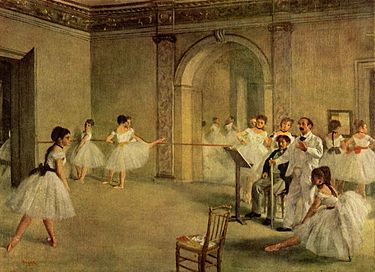 Ballet is a formalized form of dance with its origins in the French court, further developed in France and Russia as a concert dance form.
Ballet is a formalized form of dance with its origins in the French court, further developed in France and Russia as a concert dance form. -
Image 11
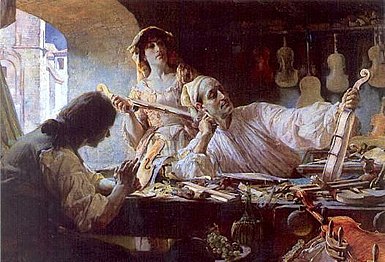 Stradivarius is one of the violins, violas, cellos and other string instruments built by members of the Italian Stradivari family, particularly Antonio Stradivari.
Stradivarius is one of the violins, violas, cellos and other string instruments built by members of the Italian Stradivari family, particularly Antonio Stradivari.
Topics
Things you can do
Associated Wikimedia
The following Wikimedia Foundation sister projects provide more on this subject:
-
Commons
Free media repository -
Wikibooks
Free textbooks and manuals -
Wikidata
Free knowledge base -
Wikinews
Free-content news -
Wikiquote
Collection of quotations -
Wikisource
Free-content library -
Wikiversity
Free learning tools -
Wiktionary
Dictionary and thesaurus
- Pages with Italian IPA
- Pages using the Phonos extension
- Pages with Russian IPA
- Pages including recorded pronunciations
- Pages with French IPA
- Pages with German IPA
- Portals with triaged subpages from June 2018
- All portals with triaged subpages
- Portals with no named maintainer
- Automated article-slideshow portals with 51–100 articles in article list
- Random portal component with more available subpages than specified max
- Random portal component with 16–20 available subpages




